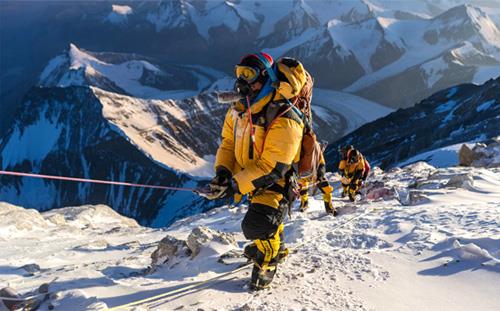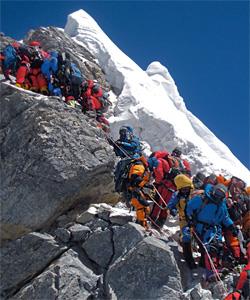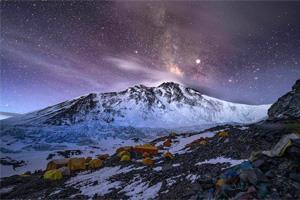
Its self-explanatory title notwithstanding, Nat Geo's new Lost On Everest ends up giving us a somewhat different story than its stars may have originally hoped.
Lost On Everest, which premieres Tuesday at 9 p.m. ET on Nat Geo, tells a surprisingly compelling story about a mountain that got a wave of unflattering publicity just last summer.
That's when we all saw a photo in which hundreds of climbers were queued up to reach the summit, looking like a line of newly hatched birds waiting for Mom to give everyone a squirt of regurgitated worm.
That photo inspired a flurry of stories suggesting that climbing Everest these days is simply a Type T exercise for bored rich people, like being helicoptered to the top of the Alps for a ski run or being lowered in a cage to commune with Great White Sharks.
 And sure enough, Lost On Everest starts with veteran climber Mark Synnot explaining that he's never climbed Everest because it holds no interest for him. There's no longer anything to explore or discover. It's simply an exercise in endurance.
And sure enough, Lost On Everest starts with veteran climber Mark Synnot explaining that he's never climbed Everest because it holds no interest for him. There's no longer anything to explore or discover. It's simply an exercise in endurance.
A moment later, Lost On Everest abruptly takes a turn, along with Synnot and fellow climber/explorer Tom Pollard.
They allow that the mountain does hold at least one major mystery: the real story of what happened to George Mallory and Sandy Irvine when those two Brits tried to climb it in 1924.
They got to least within 800 feet of the top, where a member of their support party spotted them from below. Then the mist rolled in, and neither Mallory nor Irvine was ever seen again.
Absent proof they had reached the summit, official history tells us that the first climber to do so was Sir Edmund Hillary, 29 years later, in 1953.
Still, historians have wondered whether Mallory and/or Irvine did indeed reach the summit, which, as Pollard notes, would rewrite mountain-climbing history and make them extraordinary achievers given the primitive equipment of the time.
Furthermore, one potential clue is out there that just might solve the mystery. Mallory and Irvine were known to have a camera with them. So if they reached the top and took pictures there, well, they would get their deserved recognition.
As it happens, Pollard went on an expedition in 1999 to try to find their bodies – and the camera. On the first day, they found Mallory's frozen and well-preserved body, face down, with a shattered leg. He had plenty of ID, but no camera.
The mission for Lost on Everest, then, is to find the body of Irvine, who presumably had the camera.
 Synnot and Pollard have two clues where to look. First, Everest expert Tom Holzel has long pinpointed where he believes Irvine ended up, and probably froze to death. Second, there have been two sightings – in 1960 and 1995 – of a body in that area.
Synnot and Pollard have two clues where to look. First, Everest expert Tom Holzel has long pinpointed where he believes Irvine ended up, and probably froze to death. Second, there have been two sightings – in 1960 and 1995 – of a body in that area.
It should be added, however, that Everest has more than a hundred frozen bodies since they don't decay, and it is almost impossible to bring them down. But Synnot and Pollard think their clues give them a shot at finding the one they want.
Exactly how that works out, well, we won't do spoilers here. It's a pretty compelling hunt.
Even beyond that mission, though, Lost On Everest turns out to be a superb documentary on just how hard it is to climb Mount Everest.
We watch as the lethal weather and the constant exhaustion take their toll on even the most experienced climbers. There's no way, it's clear, to make this climb without overcoming serious danger.
Synnot makes that point himself, talking about the "conga line" of climbers waiting their turn to walk those final few hundred feet to the summit.
Just getting to that point, he says, requires genuine determination and perseverance. Climbing Everest may not be exploration these days, the way it was for Mallory, Irvine, or Hillary, but it's still a battle against some of the harshest resistance nature has to offer.
The filmmakers occasionally put a little dramatic music behind the footage, much of which was shot by Nat Geo's Renan Ozturk. But mostly, Lost On Everest lets an engrossing story tell itself.